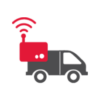Get the Whole Picture of Your Fleet with Fleet Cards and Telematics with GPS

Fleet management has evolved dramatically over the years. What used to require manual tracking and paperwork can now be managed with fleet cards. Also known as fuel cards or fleet fuel cards, these fuel payment options streamline operations and enhance fleet efficiency with real-time data, purchase controls and security. By automating fuel expense tracking with fleet cards, you can save time and money while gaining insight into fleet operations. However, when used with a fleet card, another tool can complete the picture — enter telematics with GPS.
“Every facet of driver-specific and vehicle-specific data is available when you combine fleet cards and telematics.”
Every facet of driver-specific and vehicle-specific data is available when you combine fleet cards and telematics with GPS, from purchase trends to vehicle diagnostics to driver behavior.
Let’s look at these two fleet management solutions and explore the benefits of using them together.
Understanding Fleet Cards
Fleet cards are a payment solution designed for consolidating fleet-related expenses such as fuel, parts, service and maintenance. While they function similarly to credit cards, they include features like real-time data, spending controls, detailed reporting and exception alerts to keep fleet managers informed and in control of company spending. Many fleet cards also include rebates and access to discounts on fleet-related expenses like tires, parts, service and maintenance.
Benefits of Using Fleet Cards
Real-time Data
Fleet cards track every transaction as it happens. This gives fleet managers access to real-time data like:
- Date/time of purchase
- Purchase amount
- Fuel amount
- Fuel type
- Fuel grade
- Station location
With real-time insight into fleet spending, you can make informed budgetary and management decisions. All the information necessary for tracking fuel spend is automated, so fuel expense reports or collecting receipts is no longer needed.
Purchase Controls
Fleet cards include purchase controls. Using these controls, fleet managers or business owners can customize spending parameters. Standard purchase controls include:
- Daily or weekly spending limits.
- Maximum amount per transaction.
- Maximum fuel volume.
- Specific fuel type or grade.
- Days of permitted use.
- Geographical limits.
These spending controls are a great way to help drivers adhere to fuel spending policies.
Detailed Reporting
Detailed reports and data analytics are helpful for making budgetary and managerial decisions. However, it takes time to gather the information, double-check the data and create reports for viewing as well as distribution.
With fleet cards, there is no gathering information or double-checking data — with real-time data, all of that work is completed automatically. Detailed reports can be created with the click of a button.
Security Features
Most fleet cards include advanced security features, such as unique driver IDs and real-time alerts. With a DID, no one can use a card unless they know the Driver ID Number, and the previously mentioned purchase controls help curb misuse. With real-time alerts, fleet managers can be notified of suspicious activity as soon as it happens.
Understanding Telematics

Telematics systems use GPS technology and onboard diagnostics to monitor and report various aspects of vehicle usage and performance. This means fleet managers can use telematics to gather vehicle-specific and driver-specific data.
The benefits of using telematics are vast, but we have summed them up in two categories — vehicle tracking and driver safety/behavior.
Real-time Vehicle Tracking
In fleet management, telematics systems gather and send data about a vehicle’s location, speed, mileage, engine health and more. This data is accessible through an interface where fleet managers can monitor fleet vehicle operations in real-time.
Vehicle Diagnostics
With the on-board diagnostic (OBD) component of telematics, fleet managers can monitor vehicle health from anywhere there is access to the internet. This can make keeping tabs on engine performance and maintenance needs easier.
Driver Safety and Behavior
Telematics does a lot more than monitor vehicles. It can help monitor drivers. Between the onboard diagnostics and GPS technology, fleet managers can track acceleration, braking, aggressive lane changes and idling. This data is immediately available to fleet managers, helping them highlight risky driving behaviors and target specific driver training needs.
“Combining the data and control capabilities of fleet cards with the real-time GPS tracking and reporting features of telematics creates a powerful tool for comprehensive fleet management.”
A Complete View of Your Fleet
Combining the data and control capabilities of fleet cards with the real-time GPS tracking and reporting features of telematics creates a powerful tool for comprehensive fleet management.
Correlating Driver Behavior with Fuel Consumption
Using fleet cards with telematics means you can combine relevant information. If you choose the right fleet card and telematics system, you can integrate the data so you have one source of truth for all fleet insights.
Together, telematics and fleet card data can identify the increase in fuel consumption caused by aggressive driving. This is especially helpful when a fleet manager is addressing the impacts of aggressive driving because it quantifies the effects.
Enhanced Security
Fleet cards and telematics both offer elements of security. However, when you combine the two, your assets are safer. For example, GPS data can be used to match the location of a questionable fuel purchase and vehicle tracking can confirm if a vehicle is being misused.
Improved Reporting and Analytics
Telematics and fleet card data can be combined to analyze fleet efficiency. Whether you identify significant cost-saving opportunities or reduce idling times, you’re adding to your bottom line.
Manage Maintenance
When telematics is paired with fleet cards, you can gain insights into how fuel quality impacts engine health. You also are warned of shifts in performance. Using these two sources of information, fleet managers can identify potential maintenance issues before they become major problems. Addressing maintenance needs can minimize downtime and prevent costly repairs.
Increased Visibility Means Better Fleet Management
Fleet cards simplify fuel management with automated expense tracking and purchase controls. Telematics provides real-time insight into vehicle operations and driver behavior. Together, they help fleet managers make informed decisions, enhance efficiency and run a more successful fleet.


